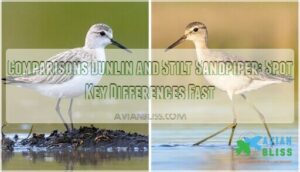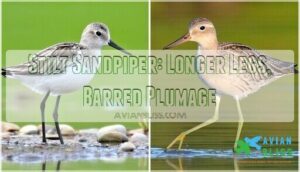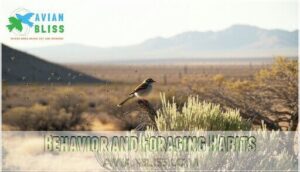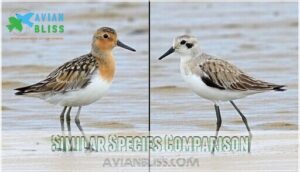This site is supported by our readers. We may earn a commission, at no cost to you, if you purchase through links.

Dunlins are the squat, black-bellied shorebirds poking around tidal mudflats, while Stilt Sandpipers sport long, greenish legs and prefer wading in freshwater marshes.
Dunlins have short, curved bills and flock in big, synchronized groups; Stilt Sandpipers show off longer, straighter bills and forage belly-deep, stitching through water.
During breeding, Dunlins flash rusty backs, but Stilt Sandpipers wear zebra-like stripes. If you’re ever stumped at the water’s edge, these clues will save the day—and there’s even more to spot if you know where to look, using these key clues.
Table Of Contents
- Key Takeaways
- Physical Characteristics
- Habitat Preferences
- Distinctive Features
- Behavior and Foraging Habits
- Similar Species Comparison
- Size and Morphological Comparisons
- Breeding and Migration Patterns
- Frequently Asked Questions (FAQs)
- What is the difference between a Dunlin and a Stilt Sandpiper?
- How do you identify a Stilt Sandpiper?
- How do you identify a Dunlin?
- What is the difference between a dunlin and a stilt sandpiper?
- What is the difference between stilt sandpipers and dowitchers?
- What is the difference between a dunlin and a white rumped sandpiper?
- What is the difference between a pectoral sandpiper and a dunlin?
- What are their typical lifespans in the wild?
- How do their population numbers and conservation statuses compare?
- What are their main predators and defense mechanisms?
- Conclusion
Key Takeaways
- You’ll spot Dunlins by their squat bodies, short curved bills, and black belly patches, usually poking around coastal mudflats.
- Stilt Sandpipers stand taller with long, greenish legs and longer, slightly curved bills, preferring freshwater marshes and ponds.
- During breeding season, Dunlins show off rusty backs and bold black bellies, while Stilt Sandpipers flash zebra-like barred underparts.
- Watch their behavior—Dunlins feed in synchronized flocks on mudflats, while Stilt Sandpipers wade belly-deep and forage solo or in small groups.
Physical Characteristics
When you’re out spotting shorebirds, you’ll notice Dunlins and Stilt Sandpipers don’t look quite the same.
Their unique shapes and colors make it easy to tell Dunlins and Stilt Sandpipers apart, even from a distance
From bill shape to leg length, these birds offer some easy clues—even if you forgot your binoculars at home.
Dunlin: Small Size, Distinctive Plumage
Identifying Dunlins starts with recognizing their compact build and striking plumage patterns. These stocky shorebirds showcase a dramatic black belly patch during breeding season, contrasting beautifully with their rusty-orange backs.
Their distinctive beak shape—short and slightly curved—helps distinguish them from other species. Understanding key bird identification features is essential for accurate species recognition.
Key dunlin identification features:
- Compact body – smaller than most shorebirds with hunched posture
- Curved bill – short with distinctive downward curve at tip
- Bold breeding colors – black belly patch with orange-mottled back
- Winter transformation – shifts to subdued grayish-brown plumage
Stilt Sandpiper: Medium Size, Unique Bill and Legs
The stilt sandpiper stands apart with its medium size and striking features.
You’ll notice its long, slightly curved bill—perfect for probing deeper than smaller shorebirds.
Those lengthy greenish legs (turning yellowish in winter) create impressive Habitat Niche Separation from coastal dunlins.
Bill Shape Variations and Leg Color Changes help distinguish this species during Migration Route Differences through inland wetlands, where Foraging Technique Adaptations shine.
Habitat Preferences
You’ll notice these two shorebirds couldn’t be more different in terms of where they hang out.
One hugs the coastline, the other prefers quiet inland marshes—two birds, two worlds apart
Dunlins stick to coastal mudflats and sandy beaches where the tide comes and goes, while Stilt Sandpipers prefer freshwater spots like marshes, ponds, and flooded fields inland.
Dunlin: Coastal Areas
You’ll spot dunlin congregating along coastal areas like mudflats, estuaries, and sandy beaches.
These adaptable shorebirds excel at tidal adaptation, timing their feeding with changing water levels.
Their impressive flocking behavior creates swirling masses during coastal migration.
Unlike their freshwater cousins, dunlin stick to shoreline habitat year-round, only heading inland for arctic breeding seasons.
Stilt Sandpiper: Freshwater Habitats
Unlike coastal-dwelling Dunlins, you’ll discover Stilt Sandpipers thriving in freshwater environments.
Their habitat selection showcases remarkable freshwater adaptation and wetland ecology preferences.
These shorebird identification guide favorites frequent:
- Shallow marshes and ponds – perfect for aquatic foraging with their long bills
- Flooded agricultural fields – rich feeding grounds during migration routes
- Prairie wetlands – essential stopover sites for stilt sandpiper migration
Their stilt sandpiper characteristics include specialized legs for wading deeper waters than most shorebirds.
This stilt sandpiper habitat preference distinguishes them clearly during stilt sandpiper identification.
Distinctive Features
You’ll notice that dunlins and stilt sandpipers have completely different body builds that make identification straightforward once you know what to look for.
The dunlin’s stocky frame and short, curved bill contrast sharply with the stilt sandpiper’s longer legs and straighter bill that help it wade into deeper water.
Dunlin: Dark Plumage, Smaller Beak
Dunlin’s dark plumage color makes shorebird comparison straightforward.
You’ll spot their smaller beak shape designed for precise probing in mudflats.
During breeding seasons, that signature black belly patch becomes unmistakable against rusty upperparts.
Their compact build and shorter, curved bill distinguish dunlin vs stilt sandpiper scenarios.
These feeding habits perfectly match their streamlined design for coastal foraging.
Stilt Sandpiper: Longer Legs, Barred Plumage
When you’re differentiating stilt sandpipers from dunlins, focus on leg structure and feather patterns.
Their long greenish legs tower over dunlin’s stubby black ones, letting them wade deeper into freshwater habitats.
The barred plumage creates distinctive zebra-like stripes across their underparts during breeding season, while their bill shape curves slightly downward.
These habitat adaptation features make dunlin vs stilt identification straightforward once you know what to look for.
Understanding the role of long leg adaptations is essential for appreciating the unique characteristics of these birds.
Behavior and Foraging Habits
You’ll notice these two shorebirds have completely different approaches to finding food, making identification much easier once you watch them in action.
Dunlins work like busy vacuum cleaners, rapidly probing mudflats with their slightly curved bills in large, synchronized flocks.
While Stilt Sandpipers act more like patient fishermen, wading belly-deep into water and methodically stitching their long bills through the substrate, showcasing a distinct approach to foraging that is quite different from the Dunlins, with their unique behavior of working in synchronized flocks.
Dunlin: Mudflats, Shallow Water
Watching these compact shorebirds work mudflats is like observing nature’s efficiency experts in action.
These feathered mudflat specialists turn coastal dining into a synchronized art form.
Dunlins have mastered mudflat ecology through specialized feeding strategies that make them coastal conservation success stories.
Their dunlin characteristics shine during shorebird migration when thousands gather on prime dunlin habitat.
The use of proper bird feeding tools is essential for their survival.
- Tactile probing – They’ll probe mud with sensitive bills, feeling for hidden invertebrates
- Synchronized flocking – Large groups create safety while maximizing food discovery
- Water depth adaptation – They’re comfortable in ankle-deep water or exposed flats
- Seasonal flexibility – These shorebird species adjust techniques based on prey availability
Stilt Sandpiper: Wading Behaviors, Feeding Habits
Stilt Sandpipers wade belly-deep in water using deliberate leg movements and rapid-fire feeding styles.
Their curved bills probe mud through tactile "stitching" techniques, targeting beetles and insect larvae. You’ll spot their distinctive wading behaviors in shallow ponds, where foraging speed varies by water depth compared to dunlin’s synchronized flock feeding.
The study of shorebird migration patterns migration habits is essential for understanding the behaviors of these birds.
| Behavior | Stilt Sandpiper |
|---|---|
| Water Depth | Belly-deep wading |
| Feeding Style | Rapid stitching jabs |
| Social Pattern | Small flocks |
| Foraging Time | Day and night |
Similar Species Comparison
You’ll often encounter several shorebird species that can look remarkably similar to dunlins and stilt sandpipers in the field.
Learning to distinguish between these closely related species will sharpen your identification skills and help you avoid common misidentification pitfalls during migration seasons.
Dunlin Compared to Red Knot, Rock Sandpiper, Sanderling
When comparing dunlin to similar shorebirds, size variations and plumage differences help with sandpiper identification.
Red Knots are larger with shorter, stouter bills, while dunlin display longer, downcurved bills perfect for deep probing.
| Feature | Dunlin | Similar Species |
|---|---|---|
| Size | 17-21 cm | Red Knot: 23-25 cm |
| Bill Shape | Long, downcurved | Sanderling: straight, short |
| Breeding Plumage | Black belly patch | Rock Sandpiper: dark breast only |
Rock Sandpipers show yellow legs versus dunlin’s black legs, while Sanderlings prefer sandy surf zones during migration patterns, contrasting dunlin’s mudflat feeding strategies.
Understanding the key differences in shorebird identification is essential for accurate classification of these species.
Stilt Sandpiper Compared to Red Knot, Sanderling, Purple Sandpiper
Shorebird identification becomes clearer when you focus on key differences. Unlike the Red Knot’s chunky profile, Stilt Sandpipers sport longer greenish legs and decurved bills.
Sanderlings run along beaches with stubby bills, while Purple Sandpipers prefer rocky coastlines.
| Species | Bill Shape | Leg Structure | Habitat Adaptation |
|---|---|---|---|
| Stilt Sandpiper | Decurved, longer | Greenish, extended | Freshwater marshes |
| Red Knot | Straight, thick | Shorter, dark | Tidal mudflats |
| Sanderling | Short, blunt | Compact, black | Sandy beaches |
| Purple Sandpiper | Yellow-based, short | Sturdy, moderate | Rocky shores |
Understanding sanderling behavior is essential for identifying these birds.
Watch for Feather Patterns and Migration Routes—these details separate similar species during peak birding seasons.
Size and Morphological Comparisons
When you’re trying to tell these shorebirds apart, size becomes your first clue—dunlins typically measure 16-22cm while stilt sandpipers average 22cm, making them noticeably larger.
You’ll also spot key differences in their bills and legs: dunlins sport shorter black legs and a finer bill with a distinct downward curve, whereas stilt sandpipers stand tall on longer pale greenish legs with a slightly drooped but less curved bill, which are noticeably larger and have distinct downward curve.
Dunlin: Smaller Size, Specific Physical Traits
Dunlin’s compact Body Size makes identification straightforward when you’re out birding.
This small shorebird measures just 16-22cm, sporting distinctive Plumage Patterns that shift seasonally.
Differentiating dunlin from larger species becomes easier once you notice their shorter, darker legs and fine Bill Shape with that telltale downward curve.
Understanding the dunlin’s bird species traits is essential for accurate identification.
| Feature | Breeding | Non-breeding | Juvenile |
|---|---|---|---|
| Feather Color | Black belly patch | Grayish-brown | Mottled back |
| Back Pattern | Rusty mottled | Brownish | Rufous-black mix |
| Head/Neck | Variable | Gray hood | Brownish face |
| Belly Development | Full black | White/gray | Growing black |
Stilt Sandpiper: Medium Size, Distinct Physical Features
You’ll recognize this medium-sized shorebird by its standout Leg Structure and Bill Shape.
The Stilt Sandpiper’s yellowish-green legs tower above other species, while its slightly drooped bill aids Habitat Adaptation in freshwater environments.
| Feature | Stilt Sandpiper | Visual Cue |
|---|---|---|
| Bill Shape | Long, slightly drooped | Curved downward at tip |
| Leg Structure | Long, yellowish-green | Noticeably taller stance |
| Feather Patterns | Barred underparts (breeding) | Distinctive striped appearance |
| Size | 22cm average length | Medium among shorebirds |
These distinct physical features make bird identification straightforward during Migration Routes through marshes and ponds.
Breeding and Migration Patterns
Understanding how these two shorebirds approach breeding and migration reveals some of their most striking differences.
You’ll discover that dunlins follow a circumpolar pattern while stilt sandpipers take a more focused Great Plains route.
Dunlin: Breeding, Wintering Locations
You’ll discover dunlin Arctic breeding grounds spanning Alaska’s tundra through northern Canada and Eurasia.
These birds travel up to 7,000 kilometers during migration routes, following Pacific Americas and East Atlantic flyways.
Their wintering habits take them to coastal migration destinations across North America’s Pacific and Atlantic shores, plus European and Asian coasts.
This impressive dunlin range showcases remarkable adaptability.
Stilt Sandpiper: Breeding Grounds, Migratory Behavior
When breeding season arrives, Stilt Sandpipers head to Arctic tundra habitats across northern Alaska and central Canada.
Their epic migration routes span over 4,000 kilometers, connecting breeding grounds to South American wintering areas.
Key migratory behavior patterns include:
- Peak southbound migration occurs August-September through Central Flyway corridors
- Freshwater stops at Great Plains wetlands and flooded grasslands for refueling
- Winter flocking in groups of 10-100 birds across Brazilian and Argentinian marshes
- Northbound return flights in April-May, following similar freshwater stopover sites
Frequently Asked Questions (FAQs)
What is the difference between a Dunlin and a Stilt Sandpiper?
You’ll spot Dunlins by their short, down-curved bills and black belly patches.
While Stilt Sandpipers flaunt long, droopy bills and greenish legs.
Dunlins stick to coasts; Stilt Sandpipers prefer freshwater marshes.
Easy as pie!
How do you identify a Stilt Sandpiper?
If you see a sandpiper with legs so long they could moonlight as stilts, you’ve found a Stilt Sandpiper.
Look for its curved bill, barred underparts, and a grayish-brown coat outside of breeding season.
How do you identify a Dunlin?
You’ll notice a Dunlin by its stocky body, short legs, and a slightly curved bill.
During breeding season, it flaunts a bold black belly patch and rusty back—kind of like it’s dressed for a fancy bird party.
What is the difference between a dunlin and a stilt sandpiper?
You’ll spot Dunlins by their short, curved bills and black belly patches in spring, while Stilt Sandpipers strut around with longer, greenish legs and barred underparts.
Dunlins stick to coasts; stilt sandpipers prefer freshwater marshes.
What is the difference between stilt sandpipers and dowitchers?
Dowitchers average 28 centimeters long, nearly 6 centimeters bigger than stilt sandpipers.
You’ll spot dowitchers by their straight, stout bills and chunky bodies, while stilt sandpipers show longer, slightly curved bills and greenish legs.
What is the difference between a dunlin and a white rumped sandpiper?
A Dunlin’s got a black belly patch during breeding, a shorter, drooped bill, and a stubbier look.
White-rumped Sandpipers have—you guessed it—a white rump, longer wings, and slimmer, sleeker bills.
Easy as pie!
What is the difference between a pectoral sandpiper and a dunlin?
Think long legs wading through shallow water and crisp bills poking mud—pectorals sport streaked chests and yellow-green legs, while dunlins flash black belly patches in spring, shorter bills, and darker legs.
You’ll spot their quirky habits quickly, and notice the distinctive features of these birds, such as black belly patches.
What are their typical lifespans in the wild?
You’ll find stilt sandpipers living about 8–10 years in the wild, while dunlins usually reach 5–10 years.
If they dodge predators and harsh weather, they can stick around long enough to see plenty of migrations.
How do their population numbers and conservation statuses compare?
Picture a seesaw—Dunlin populations balance well, staying stable, so you won’t lose sleep over their numbers.
Stilt Sandpipers tip the scale; their populations are smaller and considered “Least Concern,” but habitat loss keeps conservationists watchful, particularly over the conservationists.
What are their main predators and defense mechanisms?
You’ll spot hawks, falcons, foxes, and gulls eyeing these birds for lunch.
To dodge danger, they huddle in flocks, launch into tight, twisting flights, or freeze in place—nature’s version of hide-and-seek.
Conclusion
Did you know over 80% of North American shorebird sightings involve either dunlins or stilt sandpipers?
When you’re out birding, knowing these comparisons—dunlin and stilt sandpiper—helps you spot key differences fast.
From plumage to habitat, each clue gives you a better chance at a correct ID.
Next time you see a flock swirling over mudflats or wading in marshes, you’ll be ready to tell them apart and impress your fellow birders.
- https://www.birdobserver.org/Better-Birding/New-England-Shorebird-Guide/Dunlin-photographic-identification-guide
- https://www.allaboutbirds.org/guide/Dunlin/species-compare/
- https://www.mbr-pwrc.usgs.gov/id/htmid/h2430id.html
- https://binocularbase.com/sanderling-vs-dunlin/
- https://www.birdforum.net/threads/stilt-sandpiper-or-dunlin-tampa-march-24.454776/












